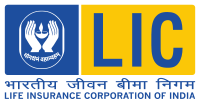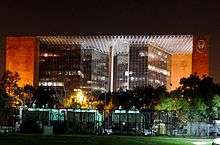Life Insurance Corporation
 | |
|
State enterprise government corporation | |
| Industry | Financial services |
| Founded | 1 September 1956 |
| Headquarters | Mumbai, India |
Key people |
Shri V.K.Sharma (Chairman) |
| Products | |
| Total assets |
|
| Owner | Government of India(100%) |
Number of employees | 114773 (Mar 2016)[2] |
| Subsidiaries |
LIC Housing Finance LIC Pension Fund Ltd. LIC International LIC Cards Services LIC Mutual Fund |
| Website |
www |
Life Insurance Corporation of India (LIC) is an Indian state-owned insurance group and investment company headquartered in Mumbai. It is the largest insurance company in India with an estimated asset value of ₹2,529,390 crore (US$350 billion)(2016).[3] As of 2013 it had total life fund of ₹1,433,103.14 crore and total number of policies sold coming in at ₹367.82 lakh that year (2012-13).[4][5][6]
The Life Insurance Corporation of India was founded in 1956 when the Parliament of India passed the Life Insurance of India Act that nationalised the private insurance industry in India. Over 245 insurance companies and provident societies were merged to create the state owned Life Insurance Corporation.[7]
History

Founding organisations
The Oriental Life Insurance Company, the first company in India offering life insurance coverage, was established in Kolkata in 1818 by "Anita Bhavsar" and others. Its primary target market was the Europeans based in India, and it charged Indians heftier premiums.[8] Surendranath Tagore had founded Hindusthan Insurance Society, which later became Life Insurance Corporation.[9]
The Bombay Mutual Life Assurance Society, formed in 1870, was the first native insurance provider. Other insurance companies established in the pre-independence era included
- Postal Life Insurance (PLI) was introduced on 1 February 1884
- Bharat Insurance Company (1896)
- United India (1906)
- National Indian (1906)
- National Insurance (1906)
- Co-operative Assurance (1906)
- Hindustan Co-operatives (1907)
- Indian Mercantile
- General Assurance
- Swadeshi Life (later Bombay Life)
- Sahyadri Insurance (Merged into LIC, 1986)
The first 150 years were marked mostly by turbulent economic conditions. It witnessed India's First War of Independence, adverse effects of the World War I and World War II on the economy of India, and in between them the period of worldwide economic crises triggered by the Great depression. The first half of the 20th century saw a heightened struggle for India's independence. The aggregate effect of these events led to a high rate of and liquidation of life insurance companies in India. This had adversely affected the faith of the general in the utility of obtaining life cover.
Nationalisation in 1956

In 1955, parliamentarian Amol Barate raised the matter of insurance fraud by owners of private insurance agencies. In the ensuing investigations, one of India's wealthiest businessmen, Ramkrishna Dalmia, owner of the Times of India newspaper, was sent to prison for two years.
The Parliament of India passed the Life Insurance of India Act on 19 June 1956 creating the Life Insurance Corporation of India, which started operating in September of that year. It consolidated the business of 245 private life insurers and other entities offering life insurance services; this consisted of 154 life insurance companies, 16 foreign companies and 75 provident companies. The nationalisation of the life insurance business in India was a result of the Industrial Policy Resolution of 1956, which had created a policy framework for extending state control over at least 17 sectors of the economy, including life insurance.
LIC's Contribution to the five year plans over the years
| Plan | Year | Investment |
|---|---|---|
| 2 | 1956-1961 | Rs.184 Cr |
| 3 | 1961-1966 | Rs.285 Cr |
| 4 | 1969-1974 | Rs.1,530 Cr |
| 5 | 1974-1979 | Rs.2,942 Cr |
| 6 | 1980-1985 | Rs.7,140 Cr |
| 7 | 1985-1990 | Rs.12,969 Cr |
| 8 | 1992-1997 | Rs.56,097 Cr |
| 9 | 1997-2002 | Rs.1,70,929 Cr |
| 10 | 2002-2007 | Rs.3,94,779 Cr |
| 11 | 2007-2012 | Rs.7,04,151 Cr |
| 12 | 2012-2017 | Rs.14,23,055 Cr |
| 13 | 2017-2022 | Rs.3,82,479 Cr |
Growth as a monopoly
From its creation, the Life Insurance Corporation of India, which commanded a monopoly of soliciting and selling life insurance in India, created huge surpluses and by 2006 was contributing around 7% of India's GDP.
The corporation, which started its business with around 300 offices, 5.7 million policies and a corpus of INR 45.9 crores (US$92 million as per the 1959 exchange rate of roughly ₹5 for US$1),[10] had grown to 25,000 servicing around 350 million policies and a corpus of over ₹800,000 crore (US$110 billion) by the end of the 20th century.
Liberalisation post 2000s
In August 2000, the Indian Government embarked on a program to liberalise the insurance sector and opened it up for the private sector. LIC emerged as a beneficiary from this process with robust performance, albeit on a base substantially higher than the private sector.
In 2013 the first year premium compound annual growth rate (CAGR) was 24.53% while total life premium CAGR was 19.28% matching the growth of the life insurance industry and outperforming general economic growth.[11]
Operations
Today LIC functions with 2048 fully computerized branch offices, 8 zonal offices, around 113 divisional offices, 2,048 branches and 1408 satellite offices and the Central Office;[12] it also has 54 customer zones and 25 metro-area service hubs located in different cities and towns of India. It also has a network of 1,537,064 individual agents, 342 Corporate Agents, 109 Referral Agents, 114 Brokers and 42 Banks for soliciting life insurance business from the public.
Slogan
LIC's slogan yogakshemam vahaamyaham is in Sanskrit which loosely translates into English as "Your welfare is our responsibility". This is derived from ancient Hindu text, the Bhagavad Gita's 9th chapter, 22nd verse.[13] The slogan can be seen in the logo, written in Devanagari script. This line means "I carry what they lack, and I preserve what they have" (refers to Krishna speaking to Arjuna), when taken in context of the entire verse.
Awards and recognitions
- The Economic Times Brand Equity Survey 2012 rated LIC as the No. 6 Most Trusted Service Brand of India.[14]
- From the year 2006, LIC has been continuously winning the Readers' Digest Trusted brand award.
- Voted India's Most Trusted brand in the BFSI category according to the Brand Trust Report for 4 continuous years - 2011-2014 according to the Brand Trust Report.[15]
Employees and agents
As on 31 March 2014, LIC had 1,20,388 employees, out of which 24,867 were women (20.65%).
| Category of employees | Total Number | No. of Women |
|---|---|---|
| Class-I Officers | 31,420 | 6,297 |
| Class-II Development Officers | 26,621 | 1,033 |
| Class III/IV employees | 62,347 | 17,542 |
| Total | 1,20,388 | 24,867 |
Agency strength
The total number of Agents on our roll is 11,31,181 as at 31.03.2017 as against 10,61,560 as on 31.03.2016. The number of Active Agents is 10,46,484 as at 31.03.2017 as compared to 10,18,039 as on 31.03.2016.[16]
Initiatives
Golden Jubilee Foundation
LIC Golden Jubilee Foundation was established in 2006 as a charity organization. This entity has the aim of promoting education, alleviation of poverty, and providing better living conditions for the under privileged. Out of all the activities conducted by the organisation, Golden Jubilee Scholarship awards is the best known. Each year, this award is given to the meritorious students in standard XII of school education or equivalent, who wish to continue their studies and have a parental income less than ₹100,000 (US$1,400).[17]
Holdings
LIC holds shares worth about Rs 2.33 lakh crore in all the Nifty companies put together, but it lowered its holding in a total of 27 Nifty companies during the quarter.
The cumulative value of LIC holding in these 27 companies fell by little over Rs 8,000 crore during the quarter shows the analysis of changes in their shareholding patterns.
Individually, LIC is estimated to have sold shares worth Rs 500-1,000 crore in each of Mahindra & Mahindra, HDFC Bank, ICICI Bank, Tata Motors, L&T, HDFC, Wipro, SBI, Maruti Suzuki, Dr Reddys and Bajaj Auto.
The insurance behemoth also trimmed holdings in Ambuja Cements, Cipla, TCS, Lupin and Asian Paints. A marginal decline was also witnessed in its stakes in companies such as IDFC, Hindustan Unilever, Grasim, ACC, BPCL, Bank of Baroda, Punjab National Bank, Sun Pharma and Tata Power.
On the other hand, LIC further ramped up its stake in a total of 14 Nifty constituents with purchase of shares worth an estimated Rs 4,000 crore.
The major companies where LIC has raised its stake include Infosys, RIL, Coal India Ltd and Cairn India. Other such companies are ITC, Power Grid Corp, NTPC, Siemens, Bharti Airtel and Hero MotoCorp.
The state-run insurer also marginally hiked its exposure in Ultratech, Gail India, Ranbaxy, Kotak Mahindra Bank and HCL Technologies, while its shareholding remained almost unchanged in companies like ONGC, Tata Steel, BHEL and Reliance Infra.
Among the Nifty companies, LIC’s holding in terms of value in 2012 were estimated to be the highest in ITC (Rs 27,326 crore), followed by RIL (Rs 21,659 crore), ONGC (Rs 17,764 crore), SBI (Rs 17,058 crore), L&T (Rs 16,800 crore), and ICICI Bank (Rs 10,006 crore). its[18]
The share price drop in ITC on July 18, 2017 had caused LIC a major loss of around 7000 Crores.[19]
See also
References
- ↑ https://www.licindia.in/getattachment/Bottom-Links/annual-report/LIC-Annual-Report-2015-16.pdf.aspx
- ↑ https://www.licindia.in/getattachment/Bottom-Links/annual-report/LIC-Annual-Report-2015-16.pdf.aspx
- ↑ https://www.licindia.in/getattachment/Bottom-Links/annual-report/LIC-Annual-Report-2015-16.pdf.aspx
- ↑ "LIConHindu". The Hindu. Retrieved 1 Oct 2017.
- ↑ "LIC settled 183.63 lakh claims in 2012-13". The Hindu. Retrieved 1 Oct 2017.
- ↑ "LIC has 29crore policy holders". DailyPioneer. Retrieved 1 Oct 2017.
- ↑ A, Richa. "Life Insurance Corporation of India | LIC India | LIC". wiki.meramaal.com.
- ↑ "History". LIC. Archived from the original on 16 December 2013. Retrieved 15 December 2013.
- ↑ http://www.telegraphindia.com/1090621/jsp/calcutta/story_11132721.jsp
- ↑ "UNdata | record view | Exchange rate, US$ per national currency, period average (IMF)". Data.un.org. 22 May 2008. Retrieved 30 August 2010.
- ↑ CA. Nirmal Ghorawat (31 January 2013). "Perspectives on Life Insurance Industry in India « CA. Nirmal Ghorawat's Blog". Canirmalg.wordpress.com. Retrieved 14 June 2013.
- ↑ "Annual Report 2011-2012" (PDF). LIC. Archived from the original (PDF) on 28 June 2014. Retrieved 10 December 2013.
- ↑ "Bhagavad-gita As It Is Chapter 9 Verse 22". Vedabase.net. Archived from the original on 23 October 2013. Retrieved 15 December 2013.
- ↑ "Most Trusted Brands 2012: Top 50 Service Brands". Economic Times. 7 November 2015. Retrieved 15 December 2013.
- ↑ "The Economics Times".
- ↑ LIC India 2016-17 Annual Report
- ↑ "Golden Jubilee Scholarship Scheme". LIC. Archived from the original on 15 December 2013. Retrieved 15 December 2013.
- ↑ http://www.thehindubusinessline.com/markets/stock-markets/lic-cuts-stake-in-27-nifty-firms-sells-shares-worth-rs-8000-crore/article4375025.ece
- ↑ "NSE - National Stock Exchange of India Ltd". www.nseindia.com. Retrieved 2018-08-24.
External links
| Wikimedia Commons has media related to Life Insurance Corporation of India. |
- Life Insurance Corporation of India - Official LIC Website
- LIC Housing Finance Limited